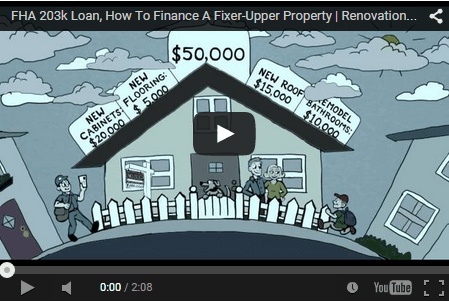Releasing 203k Funds To Contractors
The FHA 203k loan has a process for releasing funds to contractors for all of the renovation and construction work that is done on a property. No need to worry, Rehab Loan Network understands this process well, and we will be by your side to help manage the entire transaction. For your benefit, we have outlined the main steps involved in paying for the rehab work that will be fulfilled on your home.
Contractor Requirements
There will be funds set aside for the renovations by your lender in a ‘Repair Escrow’ that should be included in your mortgage. When the renovation work is completed a licensed 203k inspector will be scheduled to come out for the inspection process to ensure that all rehab work is completed and up to par. After making a determination of the work being finished only the line items that are completed will be funded.
You do have the right to be present during the time of inspection and everyone involved in this process will have to sign a Draw Inspection paperwork; this includes the borrower, the inspector, and the contractor before the paperwork can be submitted to the lender.
Process of a Draw
For the drawing process, the owner or contractor scheduling the inspection must allow the 203k inspector 1 or 2 days' notice ahead of time to be able to set a scheduled date and time. The reason for this is due to the paperwork involved since it does usually require a whole day to be sent to all parties for signatures. The lenders would then send a two-party check to the new property or the current address of the borrower. This is highly important to be certain of and let your lender know when submitting your loan application.
The check from the lender is sent by 2nd-day air making this a total of 7-10 days to complete this draw process. Also, remember to inform your contractor that 10% of each draw will be on hold until the renovation work is completed and the final inspection has taken place. The 10% usually goes into what is called the “Hold Back” account to ensure that all the work is done.
Keep in mind that you do not always need to hire a contractor to do a couple of home repairs, but you do need a licensed contractor to provide a copy of the Home Improvement License as well as a copy of the insurance along with a signed Construction Agreement that is required to be submitted to your lender before you can get final approval in the loan.
Another important thing to take into consideration when choosing a contractor is your lender’s approval of the one that you choose. Make sure you hire a reputable contractor as this individual will be fixing up your home for you to live in.
Holdbacks
A 10% holdback is required on each release from the Rehabilitation Escrow Account on all Standard 203k loans. The total sum of all holdbacks will be paid out only after the final inspection and release of the Final Notice.
The Streamlined 203k loan is designed with only two draws, and holdbacks are not applicable.
Rehabilitation Escrow Account
After the transaction is closed, the loan proceeds and the Contingency Reserve funds are placed in an interest-bearing escrow account, to be released by the lender according to FHA guidelines.
Draws / Inspections
As the work proceeds, inspections are performed by the HUD Consultant or approved lender staff at pre-specified stages, and contractors are paid through draw from the Rehabilitation Escrow Account.
Inspections and payment schedules are determined by the lender and the Work Write-Up for each project.
The first draw must not be scheduled until the lender has determined that the applicable building permits have been issued. Thereafter, inspections are performed prior to all draws by the HUD Consultant or HUD-approved lender’s staff.
Each inspection will determine whether or not the work has been completed and is compliant, and will indicate approval for funds to be released.


